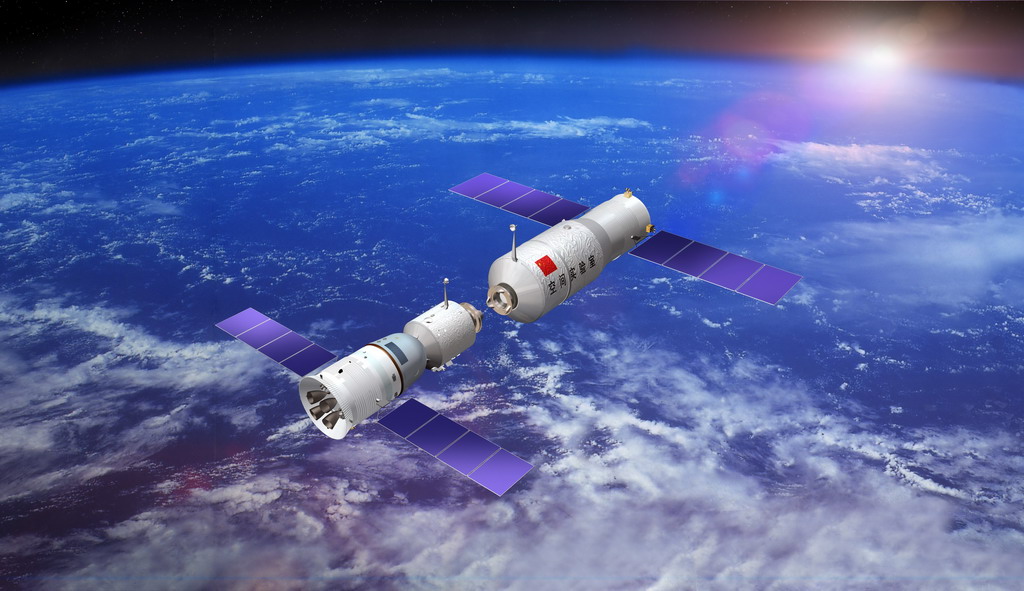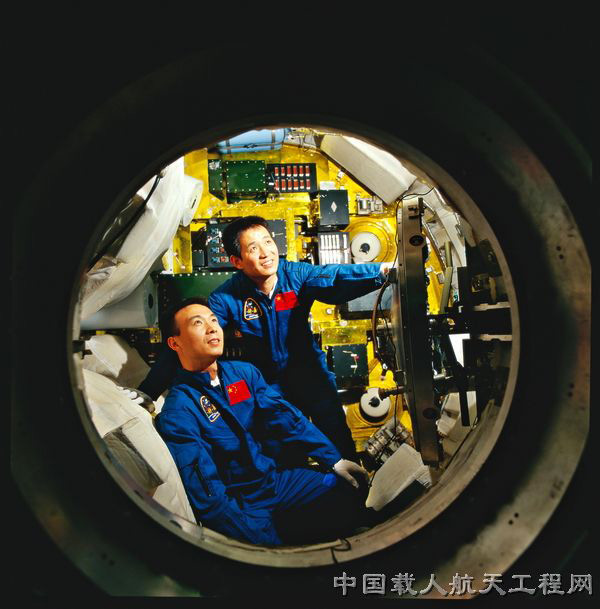
China's First Space Lab Tiangong 1 May Launch Soon

The buzz out of Beijing is that China's Tiangong 1 space lab may fly sooner than expected, perhaps soaring into space by this month's end.
That might be the case, according to China space watcher Gregory Kulacki, a senior analyst and China Project manager at the Union of Concerned Scientists (UCS). The Tiangong 1 module ("Heavenly Palace 1" in Chinese) is not China's actual space station — nor will it be a part of the planned Chinese space station, he said.
Rather, the 8-ton experimental prototype is designed as a test bed for the technologies China will need for its future space station program, including docking technology. [Photos: China's First Space Station]
Over the next two years, China is projected to launch three missions to the Tiangong I space lab. The third — and possibly second — mission is expected to carry Chinese astronauts to live and work on the Earth-orbiting facility.
Kulacki has observed that at 8 tons, China's Tiangong 1 is much smaller than the 80-ton U.S. Skylab launched in 1973, or even the 22-ton core module of Russia's Mir Space Station, which launched in 1986. Right now, the International Space Station has grown to tip the scales at 450 tons.
Looking ahead, China currently plans to complete its 70-ton space station in the early 2020s.
"Coincidentally, that is about the time that the ISS is scheduled to be decommissioned. If both those things happen, China's space station will become the de facto new international space station," Kulacki explained in a recent post on UCS's "All Things Nuclear" website.
Breaking space news, the latest updates on rocket launches, skywatching events and more!
China's space ambitions
Just what are the ripple effects stemming from China’s push forward in space station construction? Turns out it may be a bit of a Rorschach test.
There are observers that see China's playbook in space, as on the Earth, as a bid to become a world strategic power, not just a regional power.
Indeed, space for China is one piece — a significant piece, but just one — of the puzzle they are assembling, some observers say. Others contend that, when the puzzle is complete, it has China as No. 1 in the world when it comes to space, with no one else in second place.
Yet other analysts put forward that China’s Tiangong 1 is no big deal, a modest increment in space prowess. And there are those that wager China’s foothold in Earth orbit has military meaning. That’s counteracted by specialists who see a new window for U.S.-China space cooperation.
“Some members of Congress may try to use China’s progress in human space flight as an excuse to criticize the Obama administration’s space policy. Some U.S. defense analysts are likely to claim the orbiting space lab has a military purpose,” said UCS’s Kulacki.
But in reality, Kulacki told SPACE.com, Tiangong 1 is just a small step forward along the same path the United States and the Soviet Union crossed decades ago.
"Neither country discovered any practical military advantage from putting people in space. There is no indication China's human space flight program is motivated by the pursuit of military objectives, but even if it is, space professionals in the United States and Russia already know it is a fool’s errand," Kulacki said.
China's steps in space
The launch of Tiangong 1 is another modest step forward in China’s slow-paced but forward-moving human space flight program. [How China's First Space Station Will Work (Infographic)]
That’s the outlook from John Logsdon, a leading space policy expert and professor emeritus of political science and international affairs at the Space Policy Institute within George Washington University’s Elliott School of International Affairs.
Logsdon said that the Chinese space module will provide the target for gaining rendezvous and docking capabilities. Doing so somewhat mimics what NASA did during the two-seater Gemini program 45 years ago — making use of an Agena target to hone piloting skills, he said.
"But while all of Gemini's rendezvous attempts were controlled by the onboard astronauts, the Chinese are first attempting to do the link up with no crew aboard the Shenzhou 8 spacecraft. If China is successful in demonstrating automated rendezvous and docking, that will be a significant achievement," Logsdon said.
Unlike Agena, Tiangong 1 is also a small pressurized module akin to the Soviet Salyut space station of the 1970s and 1980s, and is scheduled to host at least two crews for several week stays during the Shenzhou 9 and 10 missions.
"So it is also a first step toward the larger space station that China is planning ten years from now," Logsdon said. "So while Tiangong 1 is a meaningful step for the Chinese in their plans to achieve comprehensive human spaceflight capability, it is not a threat to U.S. leadership in on-orbit capability."
The 'so what' factor
Given a new milestone in China’s space program, how best to gauge what this may mean for the United States?
That’s a much harder question to answer, said Joan Johnson-Freese, professor of national security studies at the Naval War College in Newport, R.I.
"Frankly, I don't think it will have much impact in the U.S. beyond the usual core of space enthusiasts and supporters," Johnson-Freese said. "With the U.S. economy in the state that it’s in, people worried about jobs and 401(k)s … and people feeling that Congress is focused more on politics than fixing things … I don't think what the Chinese are doing in space will register or have much impact among those who could make a difference to the U.S. space program."
Johnson-Freese added: "And another question is what difference would space supporters like it to make? Support for the James Webb Telescope? Start of a new exploration program? Expediting the Commercial Orbital Transportation Services program? What are NASA’s priorities?"
Powerful political signal
There are several points to consider regarding the imminent lofting of China's Tiangong 1, suggested Dean Cheng, a research fellow at The Heritage Foundation’s Asian Studies Center in Washington, D.C.
"The most important point is that this is developing docking techniques and technology which, in turn, means precision controls for thrusters and the like, which has obvious military/anti-satellite implications," Cheng said.
In political terms, hurling Tiangong 1 into Earth orbit, Cheng said, is another reminder that China intends to be a space player for the foreseeable future, including the realm of human spaceflight.
Just as China's naval aircraft carrier was launched soon after they criticized the U.S. for spending too much on defense, undertaking the Tiangong/Shenzhou 8 mission at about the same time as the U.S. space shuttle program ends "is a powerful political signal that China is ascendant, and the U.S. is descending," Cheng said.
Asian space race under way?
Yet another reflection is the extent to which China's space station initiative is going to spur intra-Asian space competition, Cheng continued. By launching a Skylab-type vehicle — even if significantly smaller — China is, nonetheless, going to set records for Asians in space, he said.
"In some ways, this will underscore the extent to which China is ahead of India and Japan. This will be layered atop ongoing tensions among them: Beijing-Tokyo (the Senkakus/Diaoyutai incident of last year) and Beijing-New Delhi (ongoing tensions about border demarcations),” Cheng said.
With New Delhi indicating an interest in anti-satellite capabilities, Cheng noted that Beijing's ability to sustain people in space, and associated military technology benefits — not to mention the expansion of their Tianlian data-relay satellite network nominally needed for piloted space telemetry — will be a sign of China’s edge over India in space.
Cheng’s forecast: “I think the next decade, depending on everyone’s economic development, may well see a heating up of the Asian space competition.”
Space race memories
There are those hungry for a walk down memory lane to a 1960s-like "space race" — this time between the U.S. and China — a state of affairs that could fuel America's space esprit de corps.
That idea appears to be a non-starter, suggested Roger Launius, senior curator in the Division of Space History at the Smithsonian Institution's National Air and Space Museum.
The Chinese have only flown three piloted missions since 2003 "and there are really no aggressive plans that I have seen, although there has been some reporting in the media about the possibility of a piloted Chinese moon mission. How real that is, I think, is an open question," Launius said.
Absent a serious effort by the Chinese, Launius doesn't think too many American leaders will be too concerned about increasing American funding for human spaceflight.
"Of course, having said that, if China landed on the moon, went to Tranquility Base, picked up our flag, brought it back and sold it on eBay, I think Americans would be very excited," Launius suggested.
There seems to be "enormous opportunity," Launius said, and also some "real concern" in the emergence of China as a space power.
"The opportunity comes from an increasingly capable China that might be enjoined in the international effort to create a beachhead in Earth orbit and extend human presence beyond LEO. The cooperative possibilities are intoxicating as we consider a hopeful and peaceful future exploring and using space," Launius said.
"The other side of that coin, of course, is the national security aspects of space technology," he said. "The rising capability of China has made American national security leaders nervous."
Leonard David has been reporting on the space industry for more than five decades. He is a winner of this year's National Space Club Press Award and a past editor-in-chief of the National Space Society's Ad Astra and Space World magazines. He has written for SPACE.com since 1999.

Leonard David is an award-winning space journalist who has been reporting on space activities for more than 50 years. Currently writing as Space.com's Space Insider Columnist among his other projects, Leonard has authored numerous books on space exploration, Mars missions and more, with his latest being "Moon Rush: The New Space Race" published in 2019 by National Geographic. He also wrote "Mars: Our Future on the Red Planet" released in 2016 by National Geographic. Leonard has served as a correspondent for SpaceNews, Scientific American and Aerospace America for the AIAA. He has received many awards, including the first Ordway Award for Sustained Excellence in Spaceflight History in 2015 at the AAS Wernher von Braun Memorial Symposium. You can find out Leonard's latest project at his website and on Twitter.



